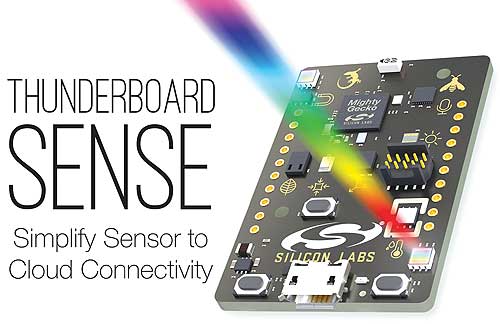 Silicon Labs has introduced a complete sensor-to-cloud development kit that provides all the hardware and software developers need to create battery-powered wireless sensor nodes for the Internet of Things (IoT). Silicon Labs’ new feature-packed Thunderboard™ Sense “inspiration kit” includes six onboard sensors, a Wireless Gecko SoC for multiprotocol cloud connectivity, 8 MB of external flash for over-the-air updates and a built-in SEGGER J-Link to simplify programming and debugging. Thunderboard Sense ships with Silicon Labs’ ready-to-use cloud-connected IoT mobile apps, making it easy to collect and view a wealth of real-time sensor data for cloud-based analytics and business intelligence.
Silicon Labs has introduced a complete sensor-to-cloud development kit that provides all the hardware and software developers need to create battery-powered wireless sensor nodes for the Internet of Things (IoT). Silicon Labs’ new feature-packed Thunderboard™ Sense “inspiration kit” includes six onboard sensors, a Wireless Gecko SoC for multiprotocol cloud connectivity, 8 MB of external flash for over-the-air updates and a built-in SEGGER J-Link to simplify programming and debugging. Thunderboard Sense ships with Silicon Labs’ ready-to-use cloud-connected IoT mobile apps, making it easy to collect and view a wealth of real-time sensor data for cloud-based analytics and business intelligence.
Get the details on Silicon Labs’ Thunderboard Sense kit including pricing, availability and videos at www.silabs.com/thunderboardsense. http://www.silabs.com/thunderboardsense Download Thunderboard mobile apps from the Apple Store and Google Play and get source code from GitHub. Discover how easy it is to develop intelligent sensor node applications for health and fitness wearables, home and industrial automation, motorized devices, asset tracking and more.
According to the IoT market research firm ON World, annual shipments of wireless sensor nodes will reach 2.5 billion units by 2021, up from 680 million this year. Short-range wireless technologies such as ZigBee®, Thread, Bluetooth® and Wi-Fi® will connect the majority of these nodes to the cloud. All-inclusive, easy-to-use development kits like Thunderboard Sense and Thunderboard React makes it easy for developers of all skill levels to create cloud-connected wireless sensing products for homes, offices, smart cities, smart grids, transportation, agriculture and asset tracking.
The latest addition to Silicon Labs’ Thunderboard family of development kits, Thunderboard Sense simplifies IoT design by providing the sensing, processing and a choice of connectivity technologies needed to connect battery-powered sensor nodes to the cloud. Onboard sensors measure data, such as motion, light and environmental conditions, and then transmit this data wirelessly to the cloud. An intuitive Android or iOS mobile app displays the data on the developer’s mobile device for data aggregation and cloud analytics.
The energy-friendly components on the Thunderboard Sense board enable developers to create wireless sensor nodes powered by small coin-cell batteries. Silicon Labs has optimized the provided firmware and mobile app to limit power consumption. Onboard sensors and LEDs can be turned on and off by the application as needed.
Developers can program Thunderboard Sense using the USB Micro-B cable and onboard J-Link debugger. A USB virtual COM port provides a serial connection to the target application. Thunderboard Sense is supported by Silicon Labs’ Simplicity Studio™ tools, and a board support package (BSP) gives users a head start in application development. Developers do not need RF design expertise to develop wireless sensor node applications with Thunderboard Sense. After connecting the board to a laptop with a USB cable, developers can get up and running in minutes with Silicon Labs’ easy-to-use Simplicity Studio tools, free mobile apps and IoT demos.
Silicon Labs
www.silabs.com


